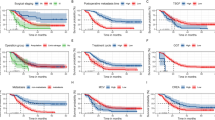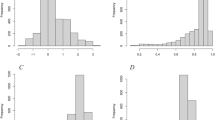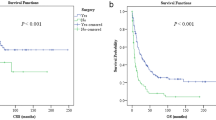Abstract
Patients with osteosarcoma have poor prognosis and are often at high risk of death. Identification of prognostic biomarkers for osteosarcoma may aid in improving the survival. Hyperuricemia had been suggested as a poor prognostic factor of several cancers, but the prognostic role of hyperuricemia in osteosarcoma patients had not been assessed. In the present study, we investigated the prognostic role of hyperuricemia at baseline on the overall survival of patients with osteosarcoma. Sixty osteosarcoma patients with hyperuricemia were matched (1:2) to 120 osteosarcoma patients without hyperuricemia with similar age and gender. Data from those patients with osteosarcoma were evaluated retrospectively. The role of hyperuricemia on overall survival was firstly analyzed using the Kaplan-Meier method. Univariate and multivariate Cox regression models were also used to further evaluate the prognostic significance of hyperuricemia. None of the clinicopathological parameters except distant metastasis was associated with hyperuricemia. Kaplan-Meier method showed that patients with hyperuricemia had shorter overall survival compared with those with normouricemia (P < 0.0001, log-rank test). In univariate analysis, hyperuricemia was associated with poorer overall survival in osteosarcoma patients (HR = 2.71, 95 % CI 1.75–4.20; P < 0.0001). In the multivariate analysis, after adjusting for age, gender, serum alkaline phosphatase, stage, tumor size, and metastasis, hyperuricemia was independently associated with poorer overall survival in osteosarcoma patients (HR = 2.28, 95 % CI 1.41–3.69; P = 0.001). In conclusion, hyperuricemia at baseline is associated with poorer overall survival in osteosarcoma patients, and it has an adverse impact on the prognosis of osteosarcoma patients.


Similar content being viewed by others
References
Moore DD, Luu HH. Osteosarcoma. Cancer Treat Res. 2014;162:65–92.
Ritter J, Bielack SS. Osteosarcoma. Ann Oncol. 2010;21(7):vii320–5.
Geller DS, Gorlick R. Osteosarcoma: a review of diagnosis, management, and treatment strategies. Clin Adv Hematol Oncol. 2010;8:705–18.
Anninga JK, Gelderblom H, Fiocco M, Kroep JR, Taminiau AH, Hogendoorn PC, et al. Chemotherapeutic adjuvant treatment for osteosarcoma: where do we stand? Eur J Cancer. 2011;47:2431–45.
Errani C, Longhi A, Rossi G, Rimondi E, Biazzo A, Toscano A, et al. Palliative therapy for osteosarcoma. Expert Rev Anticancer Ther. 2011;11:217–27.
Grignani G, Palmerini E, Dileo P, Asaftei SD, D'Ambrosio L, Pignochino Y, et al. A phase II trial of sorafenib in relapsed and unresectable high-grade osteosarcoma after failure of standard multimodal therapy: an Italian sarcoma group study. Ann Oncol. 2012;23:508–16.
Matsunobu A, Imai R, Kamada T, Imaizumi T, Tsuji H, Tsujii H, et al. Impact of carbon ion radiotherapy for unresectable osteosarcoma of the trunk. Cancer. 2012;118:4555–63.
Bramer JA, van Linge JH, Grimer RJ, Scholten RJ. Prognostic factors in localized extremity osteosarcoma: a systematic review. Eur J Surg Oncol. 2009;35:1030–6.
Clark JC, Dass CR, Choong PF. A review of clinical and molecular prognostic factors in osteosarcoma. J Cancer Res Clin Oncol. 2008;134:281–97.
Rock KL, Kataoka H, Lai JJ. Uric acid as a danger signal in gout and its comorbidities. Nat Rev Rheumatol. 2013;9:13–23.
Alvarez-Lario B, Macarron-Vicente J. Is there anything good in uric acid? QJM. 2011;104:1015–24.
Bardin T, Richette P. Definition of hyperuricemia and gouty conditions. Curr Opin Rheumatol. 2014;26:186–91.
Ghaemi-Oskouie F, Shi Y. The role of uric acid as an endogenous danger signal in immunity and inflammation. Curr Rheumatol Rep. 2011;13:160–6.
Kim SY, Guevara JP, Kim KM, Choi HK, Heitjan DF, Albert DA. Hyperuricemia and coronary heart disease: a systematic review and meta-analysis. Arthritis Care Res. 2010;62:170–80.
Kim SY, Guevara JP, Kim KM, Choi HK, Heitjan DF, Albert DA. Hyperuricemia and risk of stroke: a systematic review and meta-analysis. Arthritis Rheum. 2009;61:885–92.
Strasak AM, Rapp K, Hilbe W, Oberaigner W, Ruttmann E, Concin H, et al. The role of serum uric acid as an antioxidant protecting against cancer: prospective study in more than 28 000 older Austrian women. Ann Oncol. 2007;18:1893–7.
Strasak AM, Rapp K, Hilbe W, Oberaigner W, Ruttmann E, Concin H, et al. Serum uric acid and risk of cancer mortality in a large prospective male cohort. Cancer Causes Control. 2007;18:1021–9.
Tanriverdi O, Cokmert S, Oktay E, Pilanci KN, Menekse S, Kocar M, et al. Prognostic significance of the baseline serum uric acid level in non-small cell lung cancer patients treated with first-line chemotherapy: a study of the Turkish descriptive oncological researches group. Med Oncol. 2014;31:217.
Stotz M, Szkandera J, Seidel J, Stojakovic T, Samonigg H, Reitz D, et al. Evaluation of uric acid as a prognostic blood-based marker in a large cohort of pancreatic cancer patients. PLoS One. 2014;9:e104730.
Leary SE, Wozniak AW, Billups CA, Wu J, McPherson V, Neel MD, et al. Survival of pediatric patients after relapsed osteosarcoma: the St. Jude Children’s Research Hospital experience. Cancer. 2013;119:2645–53.
Song HJ, Lee EK, Lee JA, Kim HL, Jang KW. The addition of mifamurtide to chemotherapy improves lifetime effectiveness in children with osteosarcoma: a Markov model analysis. Tumour Biol. 2014;35:8771–9.
Shin HS, Lee HR, Lee DC, Shim JY, Cho KH, Suh SY. Uric acid as a prognostic factor for survival time: a prospective cohort study of terminally ill cancer patients. J Pain Symptom Manag. 2006;31:493–501.
Szkandera J, Gerger A, Liegl-Atzwanger B, Stotz M, Samonigg H, Ploner F, et al. Uric acid levels in blood are associated with clinical outcome in soft-tissue sarcoma patients. Clin Chem Lab Med. 2015;53:493–7.
Bacci G, Picci P, Ferrari S, Orlandi M, Ruggieri P, Casadei R, et al. Prognostic significance of serum alkaline phosphatase measurements in patients with osteosarcoma treated with adjuvant or neoadjuvant chemotherapy. Cancer. 1993;71:1224–30.
Bacci G, Longhi A, Ferrari S, Lari S, Manfrini M, Donati D, et al. Prognostic significance of serum alkaline phosphatase in osteosarcoma of the extremity treated with neoadjuvant chemotherapy: recent experience at Rizzoli Institute. Oncol Rep. 2002;9:171–5.
Sautin YY, Johnson RJ. Uric acid: the oxidant-antioxidant paradox. Nucleosides Nucleotides Nucleic Acids. 2008;27:608–19.
Preitner F, Laverriere-Loss A, Metref S, Da Costa A, Moret C, Rotman S, et al. Urate-induced acute renal failure and chronic inflammation in liver-specific Glut9 knockout mice. Am J Physiol Ren Physiol. 2013;305:F786–95.
Bo S, Gambino R, Durazzo M, Ghione F, Musso G, Gentile L, et al. Associations between serum uric acid and adipokines, markers of inflammation, and endothelial dysfunction. J Endocrinol Investig. 2008;31:499–504.
Strazzullo P, Puig JG. Uric acid and oxidative stress: relative impact on cardiovascular risk? Nutr Metab Cardiovasc Dis. 2007;17:409–14.
Karbowska A, Boratynska M, Kusztal M, Klinger M. Hyperuricemia is a mediator of endothelial dysfunction and inflammation in renal allograft recipients. Transplant Proc. 2009;41:3052–5.
Conflicts of interest
None
Author information
Authors and Affiliations
Corresponding author
Rights and permissions
About this article
Cite this article
Wang, S., Liu, X., He, Z. et al. Hyperuricemia has an adverse impact on the prognosis of patients with osteosarcoma. Tumor Biol. 37, 1205–1210 (2016). https://doi.org/10.1007/s13277-015-3830-3
Received:
Accepted:
Published:
Issue Date:
DOI: https://doi.org/10.1007/s13277-015-3830-3




